Navigating the Complex World of Container Orchestration
Modern software development has embraced containers for their portability and efficiency. However, managing hundreds or even thousands of these containers across a distributed environment presents a significant operational challenge. This is the core problem solved by container orchestration tools: they automate the deployment, management, scaling, and networking of containers, transforming a complex manual process into a manageable, automated workflow. Without effective orchestration, the benefits of containerisation quickly diminish under the weight of operational complexity, leading to system instability and increased maintenance overheads.
Choosing the right platform is critical for any organisation, from a nimble startup to a large enterprise IT department. The decision impacts everything from developer productivity and infrastructure costs to application reliability and scalability. This comprehensive resource is designed to cut through the noise and provide a clear, practical guide to the leading container orchestration tools available today. We will move beyond generic feature lists and marketing claims to deliver an in-depth analysis of each solution.
This article provides a detailed breakdown of the most impactful tools in the ecosystem, including both foundational platforms and managed service offerings. For each tool, you will find:
- A detailed overview of its core architecture and philosophy.
- An honest assessment of its strengths and limitations.
- Specific, real-world use cases to illustrate where it excels.
- Practical implementation considerations for DevOps and infrastructure teams.
We will explore industry standards like Kubernetes and Docker Swarm, enterprise-grade platforms such as Red Hat OpenShift, and flexible alternatives like HashiCorp Nomad. We will also analyse the major managed Kubernetes services from AWS, Google Cloud, and Azure, helping you determine which platform best aligns with your technical requirements, team expertise, and business objectives.
1. Kubernetes
Dominating the landscape of container orchestration tools, Kubernetes (often stylised as K8s) is the de facto standard for automating the deployment, scaling, and operational management of containerised applications. Originally an internal Google project named Borg, its open-source release revolutionised how developers and DevOps teams approach distributed systems. It provides a robust, declarative framework for defining application states, allowing the system to handle the underlying complexity of maintaining that state across a cluster of machines.

Its powerful feature set is extensive, including automated rollouts that prevent downtime by incrementally updating applications and immediate rollbacks to a previous stable version if something goes wrong. This, combined with self-healing capabilities that automatically restart, replace, or reschedule failed containers, makes it ideal for building resilient, highly available services.
Core Features & Use Cases
Kubernetes excels in complex, large-scale environments. A primary use case is creating a microservices architecture where each service runs in its own container, managed and orchestrated by K8s for seamless communication and scaling. It’s also perfectly suited for lift-and-shift migrations, enabling enterprises to move legacy applications into a modern, cloud-native infrastructure without significant re-architecting. For organisations adopting hybrid or multi-cloud strategies, Kubernetes provides a consistent operational layer, abstracting away the differences between on-premises data centres and various public cloud providers.
- Self-healing: Automatically restarts containers that fail, replaces and reschedules containers when nodes die.
- Horizontal Scaling: Scale applications up or down with a simple command, a UI, or automatically based on CPU usage.
- Service Discovery: Exposes containers using a DNS name or their own IP address and can load-balance traffic across them.
Implementation & Considerations
Despite its power, Kubernetes is notoriously complex. The initial setup and ongoing maintenance demand specialised expertise, making the learning curve steep. While the core software is open-source and free, total cost of ownership includes infrastructure expenses and the significant operational overhead of managing the cluster. To mitigate this, many organisations opt for managed Kubernetes services like Google Kubernetes Engine (GKE), Amazon Elastic Kubernetes Service (EKS), or Azure Kubernetes Service (AKS). These managed offerings handle the control plane, simplifying cluster management significantly. When starting, it is crucial to adhere to established guidelines. To get started on the right foot, it’s beneficial to learn more about Kubernetes best practices.
2. Docker Swarm
As Docker’s native solution among container orchestration tools, Docker Swarm mode is designed for simplicity and ease of use, providing a streamlined alternative to more complex systems. It is built directly into the Docker Engine, allowing developers familiar with Docker commands to manage a cluster of Docker nodes as a single, virtual system. Its architecture prioritises straightforward setup and operation, making it an excellent choice for teams that want orchestration capabilities without the steep learning curve associated with platforms like Kubernetes.

Docker Swarm’s appeal lies in its seamless integration into the Docker ecosystem. It uses the same command-line interface (CLI) and a declarative service model, which simplifies deploying, scaling, and updating services. Features like rolling updates and built-in load balancing are included out-of-the-box, offering robust functionality for many common scenarios without requiring extensive configuration or third-party add-ons.
Core Features & Use Cases
Docker Swarm is ideal for small to medium-sized deployments, development or testing environments, and organisations deeply invested in the Docker ecosystem that prefer not to introduce another layer of complexity. It is particularly well-suited for stateful applications or simpler microservices architectures where the overhead of Kubernetes is unnecessary. A key use case is for teams needing to get a containerised application up and running quickly, as a functional cluster can be established in minutes.
- Simple & Fast Setup: Initialise a cluster with just two commands, making it highly accessible.
- Decentralised Design: Swarm managers and workers are easy to configure, providing high availability.
- Declarative Service Model: Define the desired state of your services in a YAML file and let Swarm maintain it.
Implementation & Considerations
The primary strength of Docker Swarm, its simplicity, is also linked to its main limitation: it is less feature-rich than Kubernetes. The community and third-party tooling ecosystem are smaller, meaning fewer integrations and pre-built solutions are available. However, for many projects, this is a worthwhile trade-off for its lower operational overhead and resource footprint. It’s a pragmatic choice for teams that do not need the extensive customisation options of K8s. As it works with standard Dockerfiles, ensuring they are well-structured is vital; you can get started with a comprehensive guide to linting Dockerfiles to ensure optimal performance.
3. Red Hat OpenShift
Positioned as an enterprise-grade Kubernetes platform, Red Hat OpenShift builds upon the core of Kubernetes to deliver a more comprehensive and developer-centric experience. While vanilla Kubernetes provides the foundational engine, OpenShift is an opinionated distribution that packages Kubernetes with additional tooling, enhanced security, and enterprise support. It is designed for organisations that require a turn-key solution for building, deploying, and managing containerised applications at scale, with a strong focus on security and regulatory compliance from the outset.
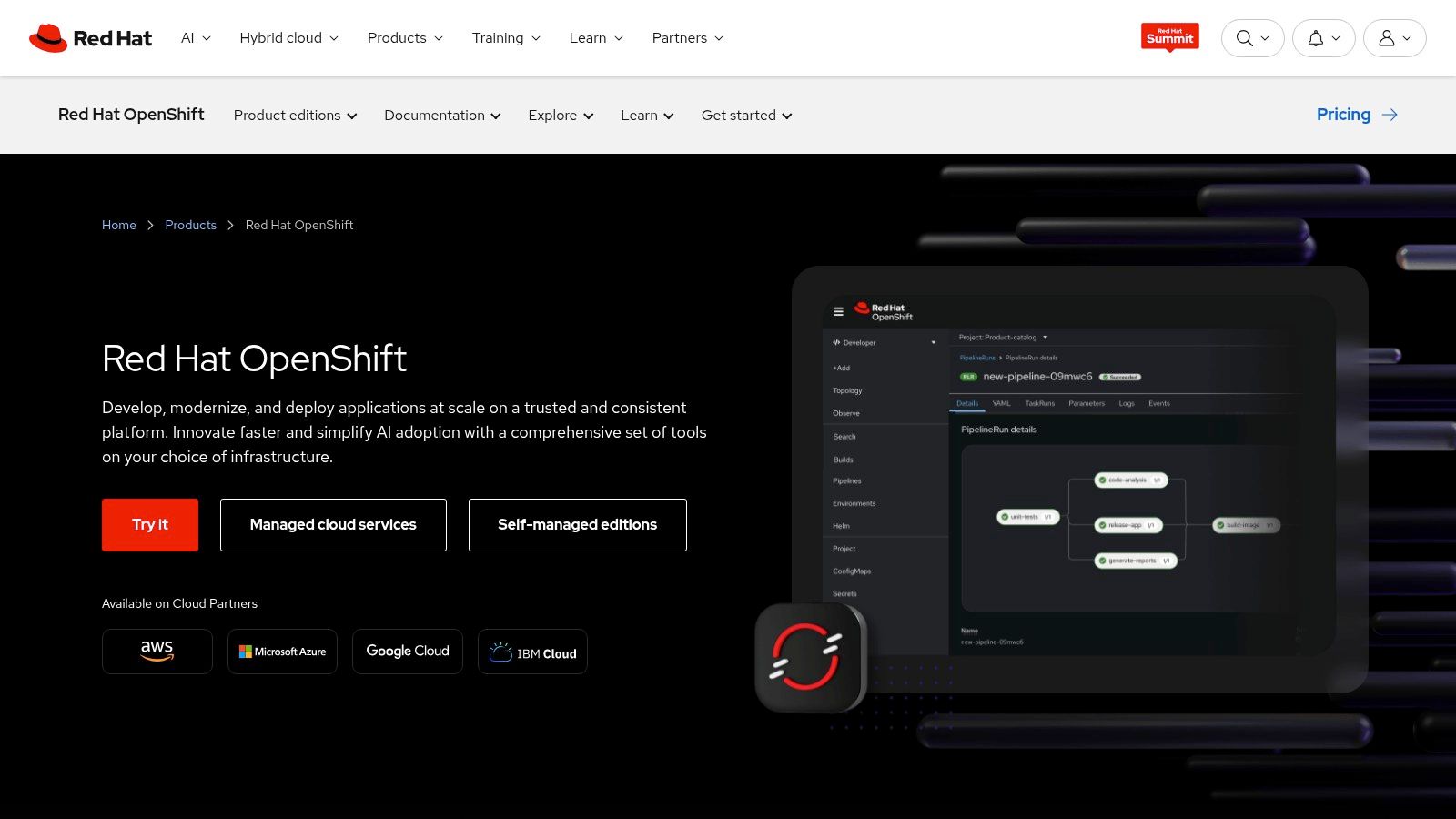
This platform integrates everything from the container runtime and networking to monitoring and registry services, creating a cohesive ecosystem. By offering features like integrated CI/CD pipelines and a developer-friendly console, OpenShift aims to accelerate the application lifecycle, making it one of the more productive container orchestration tools for large development teams.
Core Features & Use Cases
OpenShift excels in regulated industries like finance, healthcare, and government, where security and compliance are paramount. Its built-in security context constraints (SCCs) and robust role-based access control (RBAC) provide granular control over what containers can do. A primary use case is creating a standardised development platform across an entire organisation, ensuring consistency from development to production. It is also ideal for hybrid cloud strategies, offering a consistent management plane for applications deployed on-premises and across various public clouds.
- Integrated CI/CD: Built-in Jenkins pipelines for automated build and deployment workflows.
- Enhanced Security: Includes advanced security controls and compliance features out-of-the-box.
- Developer-Centric Tools: Provides a rich command-line tool (
oc) and a web console that simplifies application management.
Implementation & Considerations
While OpenShift simplifies many aspects of Kubernetes, its layered architecture introduces its own complexity and a steeper learning curve compared to some alternatives. The cost is a significant factor; it is a premium, subscription-based product, making it less suitable for small teams or startups. The total cost of ownership, including the subscription and infrastructure, can be substantial. However, for large enterprises, this cost is often justified by the included Red Hat support, stability, and integrated security features. Implementation is streamlined through automated installers that work across bare metal, virtualised environments, and major cloud providers.
4. HashiCorp Nomad
Positioning itself as a simpler and more flexible alternative in the world of container orchestration tools, HashiCorp Nomad offers a lightweight yet powerful solution for workload orchestration. Unlike orchestrators that exclusively manage containers, Nomad is designed with a general-purpose workload scheduler that can deploy and manage both containerised and non-containerised applications. This versatility makes it an excellent choice for organisations with heterogeneous environments, allowing them to unify their orchestration strategy across legacy applications, virtual machines, and modern containers.
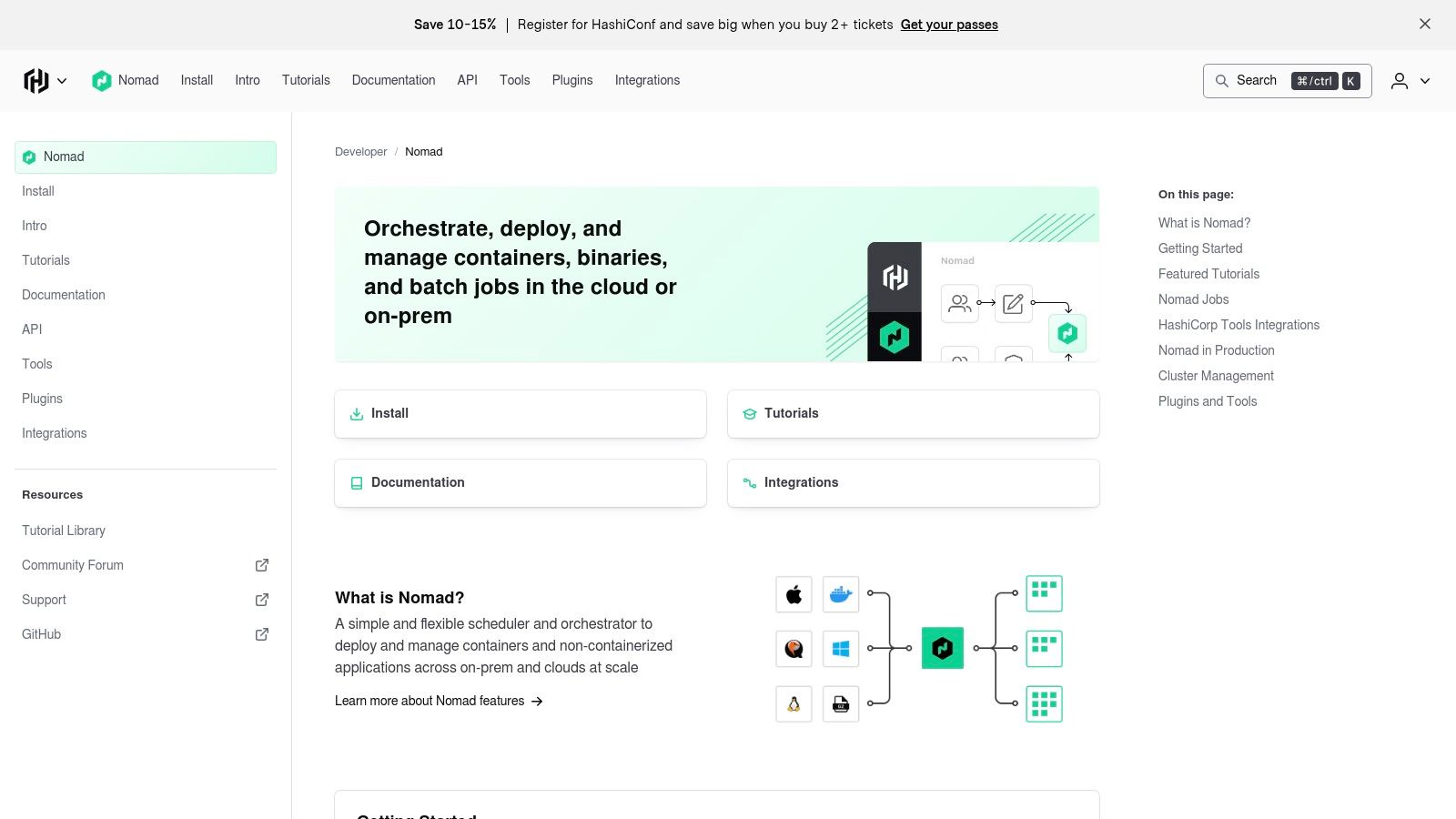
Nomad is architected as a single binary for both clients and servers, drastically simplifying installation and operational management. Its focus on simplicity does not compromise on scalability; a single Nomad cluster can scale to thousands of nodes across multiple data centres and regions. This makes it a compelling option for teams that need robust orchestration without the significant operational overhead associated with more complex systems like Kubernetes.
Core Features & Use Cases
Nomad’s key strength is its flexibility. A primary use case is for organisations looking to gradually modernise their infrastructure. They can start by orchestrating existing virtual machine or standalone application deployments and later introduce containerised workloads without needing a separate tool. It excels in edge computing scenarios where resource constraints and simplicity are critical. Furthermore, its native integration with other HashiCorp products like Consul for service discovery and Vault for secrets management creates a powerful, cohesive ecosystem for building, securing, and running applications.
- Workload Flexibility: Natively supports Docker, QEMU, Java, and standalone binaries without custom plugins.
- Multi-Region Federation: Manage a fleet of clusters across different data centres and cloud providers as a single entity.
- Simple & Scalable Architecture: Deploys as a single binary, significantly reducing operational complexity and resource footprint.
Implementation & Considerations
The primary advantage of Nomad is its ease of use and low barrier to entry. Setup is straightforward, and its declarative job file format is intuitive for developers and operators. While the open-source version is free, HashiCorp offers Nomad Enterprise with advanced features like governance and policy management. The main consideration is its smaller ecosystem compared to Kubernetes. While the core functionality is robust, the availability of third-party tools, integrations, and community-driven support is more limited. For teams already invested in the HashiCorp ecosystem, adopting Nomad is a natural and highly efficient choice. For more details, visit the official Nomad website.
5. Apache Mesos
Positioned as a distributed systems kernel, Apache Mesos offers a unique approach among container orchestration tools by abstracting CPU, memory, storage, and other compute resources away from machines. This enables fault-tolerant and elastic distributed systems to be built and run easily. Mesos acts as a powerful resource manager, allowing multiple diverse frameworks, from container orchestrators like Marathon to big data systems like Spark and Hadoop, to run on the same cluster, sharing resources efficiently.

Its two-level scheduling architecture is what sets it apart. Mesos delegates scheduling decisions to the frameworks themselves, which allows each framework to implement its own application-aware scheduling logic while Mesos ensures fair resource allocation across all of them. This makes it a highly versatile platform for organisations running a mix of containerised microservices and traditional big data workloads.
Core Features & Use Cases
Apache Mesos is ideal for large-scale enterprises that need to run heterogeneous workloads on a shared pool of resources. A key use case is unifying infrastructure for both stateless microservices and stateful data processing jobs. For instance, a company could run its containerised web applications using the Marathon framework while simultaneously running analytical queries with Spark, all managed by the same Mesos cluster. This avoids resource siloing and maximises hardware utilisation across the data centre. It is proven to scale to tens of thousands of nodes.
- Fine-grained Resource Sharing: Enables multiple frameworks to share cluster resources with high efficiency.
- Framework-agnostic Platform: Supports a wide variety of workloads, including Docker containers, big data applications, and more.
- High Scalability: Architected to manage extremely large clusters with tens of thousands of nodes and applications.
Implementation & Considerations
The primary challenge with Mesos is its complexity. Its two-level scheduling model and the need to manage both Mesos and its application frameworks (like Marathon for containers) introduce a steep learning curve. While incredibly powerful for its intended use case of mixed-workload management, it can be overkill if the only goal is container orchestration, where Kubernetes now offers a more focused and widely adopted solution. Deployment requires significant expertise in distributed systems. For organisations heavily invested in diverse Apache ecosystem projects, Mesos provides a cohesive, highly scalable foundation, but for purely container-focused teams, managed Kubernetes services are often a more direct path.
6. Rancher
Rather than being one of the direct container orchestration tools itself, Rancher is an open-source management platform built to tame the complexity of Kubernetes. It provides a unified, intuitive user interface for deploying and managing Kubernetes clusters anywhere, from on-premises data centres to public cloud providers or edge locations. This centralisation simplifies operations, allowing teams to manage multiple clusters, regardless of their underlying distribution (like K3s, RKE, EKS, AKS, or GKE), from a single control plane.

Its core value lies in abstracting away the operational friction of Kubernetes. Rancher makes sophisticated features like integrated monitoring with Prometheus and Grafana, centralised logging, and global security policy enforcement accessible without deep command-line expertise. This approach democratises Kubernetes, making it more approachable for organisations that lack dedicated K8s specialists.
Core Features & Use Cases
Rancher is ideal for organisations running Kubernetes in hybrid or multi-cloud environments. Its primary use case is providing a consistent management layer across disparate infrastructure, enabling centralised authentication, access control, and policy enforcement. For development teams, its application catalogue, powered by Helm, simplifies the deployment of common applications and services with one-click installations. This dramatically speeds up the process of getting new environments and tools running for developers.
- Multi-cluster Management: Deploy and manage Kubernetes clusters across any private or public infrastructure from a single interface.
- Integrated Tooling: Comes with pre-packaged monitoring, logging, and alerting tools, reducing setup complexity.
- Centralised Security: Enforce consistent security and access control policies (RBAC) across all managed clusters.
Implementation & Considerations
While Rancher simplifies Kubernetes management, it is an additional layer of abstraction that sits on top of your clusters. This can introduce its own set of complexities and potential points of failure. The platform itself needs to be installed, managed, and maintained. A foundational understanding of Kubernetes concepts is still necessary to use Rancher effectively, as it does not completely eliminate the need for K8s knowledge. The open-source version is free, but SUSE offers enterprise-grade support through Rancher Prime. For implementation, ensure the server running Rancher has adequate resources and secure network access to the API endpoints of all Kubernetes clusters it will manage.
7. Portainer
Positioning itself as a user-friendly management layer, Portainer simplifies the world of container orchestration tools by providing a powerful graphical user interface (GUI). Instead of focusing solely on CLI-based operations, it offers an intuitive visual platform for managing Docker, Docker Swarm, and Kubernetes environments. This approach significantly lowers the barrier to entry, making container management accessible to developers, IT administrators, and operations teams who may not have deep expertise in command-line interfaces. It acts as a central control panel, streamlining day-to-day container-related tasks.
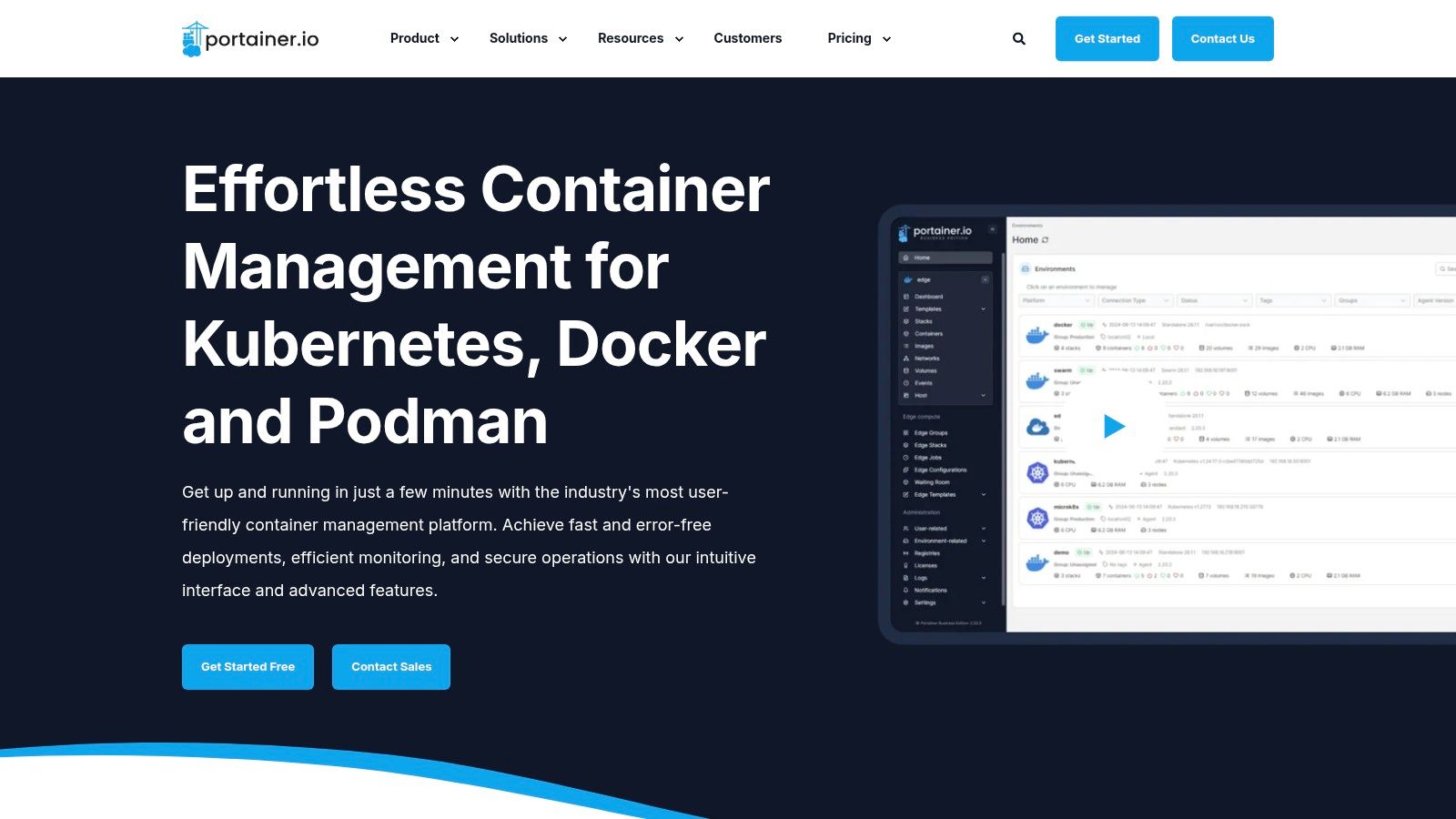
Portainer’s appeal lies in its ability to bring clarity and control to complex container ecosystems. It enables users to deploy, monitor, and troubleshoot applications with just a few clicks. The platform organises containerised resources logically, from images and volumes to networks and running containers, providing a holistic view of the entire environment. This visual abstraction is especially valuable for teams managing multi-cluster setups across different platforms.
Core Features & Use Cases
Portainer excels in scenarios where simplicity and rapid onboarding are paramount. A common use case is for small to medium-sized businesses or development teams that need container management without the steep learning curve of raw Kubernetes. It’s ideal for deploying applications quickly using pre-built templates, managing access with role-based controls (RBAC), and giving developers self-service capabilities within governed boundaries. For organisations running Docker Swarm, Portainer remains one of the most effective and popular management GUIs available.
- Multi-cluster Management: Manage and switch between multiple Docker, Swarm, or Kubernetes clusters from a single interface.
- Application Templates: Utilise one-click deployment for common applications like Nginx, WordPress, or databases.
- Role-Based Access Control (RBAC): Define granular permissions for users and teams to secure the environment.
Implementation & Considerations
Deploying Portainer is straightforward; it runs as a lightweight container itself. The Community Edition is free and open-source, making it highly accessible. For more advanced enterprise needs, a Business Edition offers features like enhanced security and dedicated support. A key consideration is that Portainer is an abstraction layer. While it simplifies many tasks, power users may find themselves returning to the CLI for highly complex or specific Kubernetes operations. It is not a replacement for understanding the underlying orchestrator but rather a powerful tool to augment and streamline its management. You can get started with Portainer here.
8. Amazon Elastic Kubernetes Service (EKS)
For organisations deeply embedded in the Amazon Web Services ecosystem, Amazon Elastic Kubernetes Service (EKS) stands out as a premier managed container orchestration tool. It is designed to take the operational burden out of running Kubernetes on AWS, allowing teams to focus on building applications rather than managing infrastructure. EKS provides a fully managed, certified Kubernetes control plane, ensuring high availability and automating critical tasks like patching, node provisioning, and updates. This approach simplifies deploying, managing, and scaling containerised applications using Kubernetes on AWS.
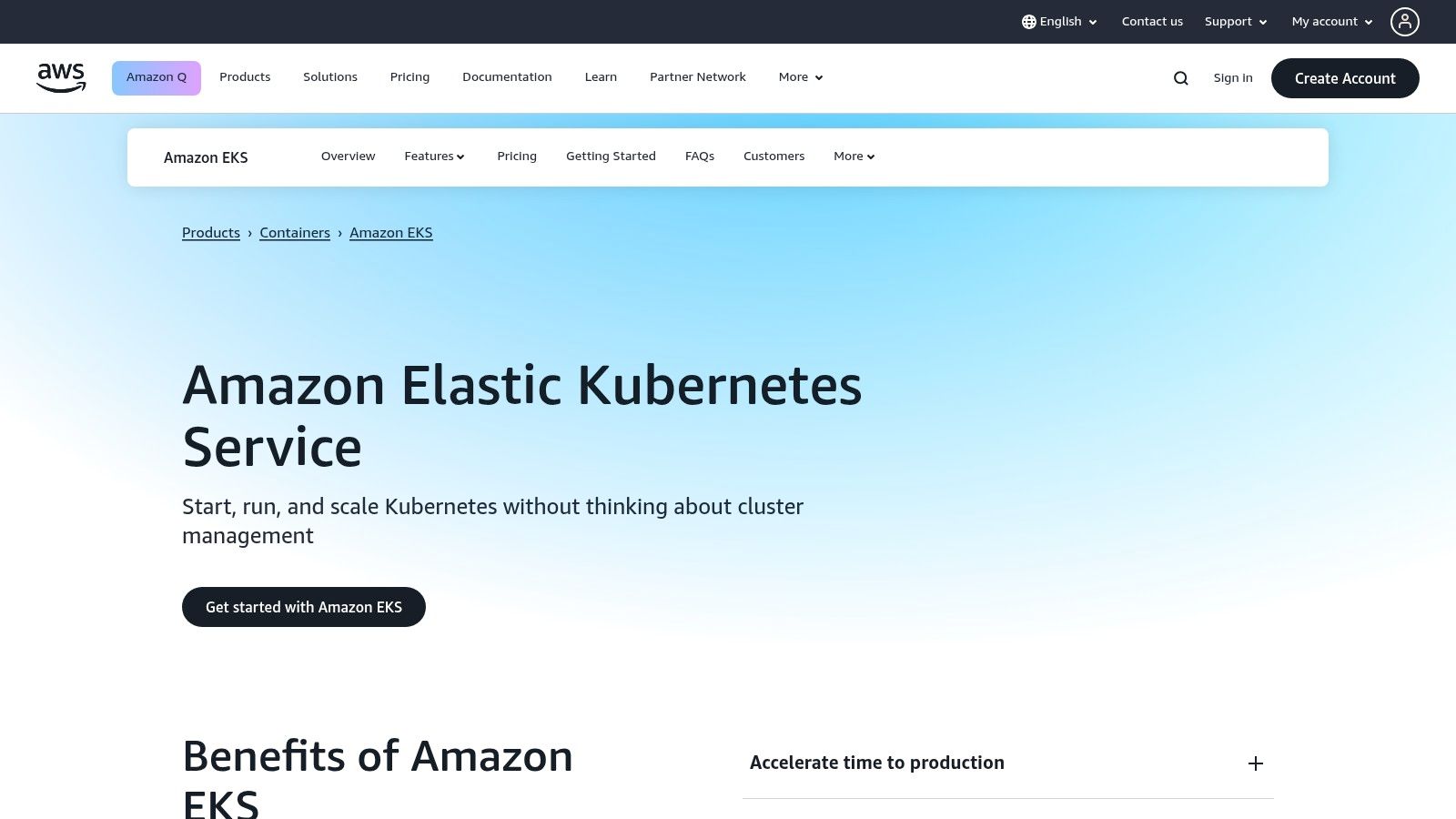
Its primary strength lies in its native integration with the broader suite of AWS services. From IAM for secure authentication to VPC for network isolation and Elastic Load Balancing for traffic distribution, EKS creates a seamless and powerful environment. This deep integration makes it an ideal choice for enterprises that have standardised on AWS and want to leverage their existing cloud expertise and infrastructure investments.
Core Features & Use Cases
EKS is perfectly suited for enterprises running large-scale production workloads on AWS. A common use case involves deploying complex microservices architectures that require robust security, networking, and observability, all of which are readily available through native AWS integrations. It is also a powerful platform for machine learning (ML) workloads, leveraging integrations with Amazon SageMaker and the ability to provision GPU-powered instances for training models. For businesses looking at hybrid cloud, EKS Anywhere allows for creating and operating Kubernetes clusters on-premises while maintaining operational consistency with AWS.
- Managed Control Plane: AWS manages the availability and scalability of the Kubernetes control plane nodes.
- Deep AWS Integration: Natively integrates with services like CloudWatch, Auto Scaling Groups, IAM, and VPC.
- Serverless Compute: Supports AWS Fargate, allowing you to run containers without managing servers or clusters.
Implementation & Considerations
While EKS simplifies Kubernetes, it is not a free service. AWS charges an hourly rate for each EKS cluster, in addition to the cost of the EC2 instances or Fargate resources that run your worker nodes. The primary trade-off is cost versus operational simplicity. This makes it crucial for organisations to perform a thorough cloud provider comparison to understand the total cost of ownership. The main drawback is the inherent vendor lock-in; EKS is designed exclusively for the AWS environment. Migrating an EKS-optimised application to another cloud or on-premises data centre would require significant re-engineering efforts.
9. Google Kubernetes Engine (GKE)
As one of the pioneering managed Kubernetes offerings, Google Kubernetes Engine (GKE) leverages Google’s immense experience running production workloads like Search and Gmail in containers. It abstracts away much of the underlying complexity of vanilla Kubernetes, providing a production-ready environment for deploying, managing, and scaling containerised applications on Google Cloud. GKE is a leading choice among container orchestration tools for teams who want the power of Kubernetes without the operational overhead of managing the control plane.
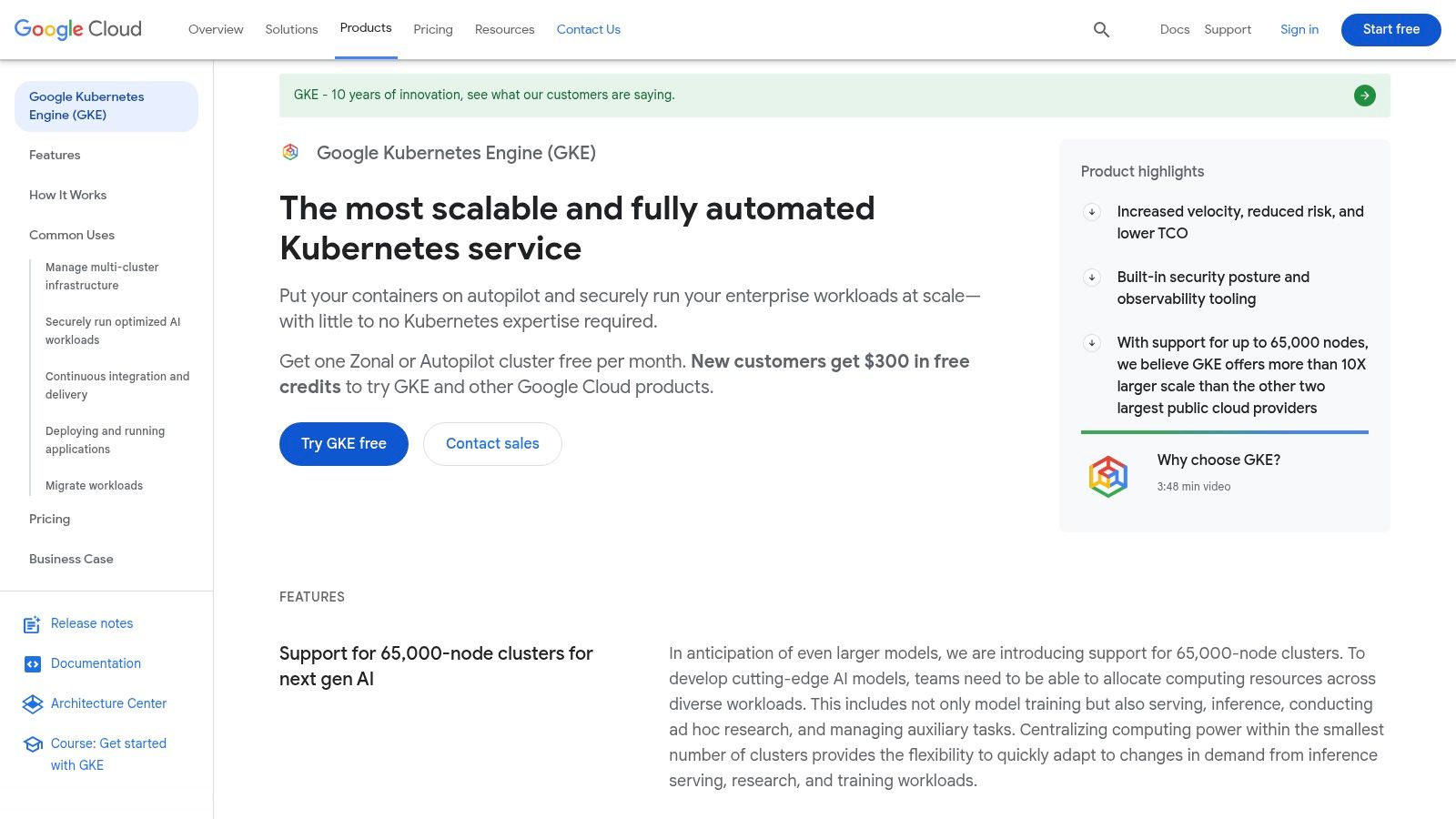
It offers a hardened, highly available, and scalable environment with automated cluster lifecycle management, including auto-upgrades and auto-repairs. This allows development teams to focus on building applications rather than managing infrastructure. Its seamless integration with the broader Google Cloud ecosystem, including Cloud Logging, Monitoring, and Identity and Access Management (IAM), provides a cohesive and secure operational experience out of the box.
Core Features & Use Cases
GKE is particularly powerful for organisations deeply invested in the Google Cloud ecosystem. A primary use case is building cloud-native applications that require robust auto-scaling to handle variable traffic loads, a feature GKE excels at with its cluster and pod autoscalers. It’s also ideal for running stateful applications like databases by leveraging Google’s Persistent Disk. For enterprises adopting a hybrid cloud model, GKE, combined with Google Anthos, provides a consistent platform for managing workloads both on-premises and in the cloud.
- Autopilot Mode: A hands-off operational mode where GKE manages the entire cluster infrastructure, including nodes.
- Integrated Observability: Natively integrates with Cloud Logging and Cloud Monitoring for deep insights into application performance.
- Multi-cluster Support: Enables deploying applications across multiple GKE clusters in different regions for high availability and low latency.
Implementation & Considerations
Getting started with GKE is significantly simpler than a self-managed Kubernetes deployment, with a new cluster creatable in minutes via the UI or command line. While GKE is a managed service, it is primarily tied to the Google Cloud Platform, which can lead to vendor lock-in. Cost management is also a key consideration; while the Autopilot mode can optimise resource usage, organisations must monitor their consumption of underlying compute and storage resources to avoid unexpected bills. GKE offers a free tier, but production usage incurs costs for the cluster management fee and the worker nodes.
10. Azure Kubernetes Service (AKS)
For organisations deeply integrated into the Microsoft ecosystem, Azure Kubernetes Service (AKS) stands out among container orchestration tools as a premier managed offering. It abstracts away the operational overhead of managing a Kubernetes control plane, allowing development and operations teams to focus purely on application workloads. AKS simplifies the deployment and management of containerised applications by providing a fully managed environment with integrated CI/CD pipelines, advanced identity and access management through Azure Active Directory, and extensive monitoring capabilities.
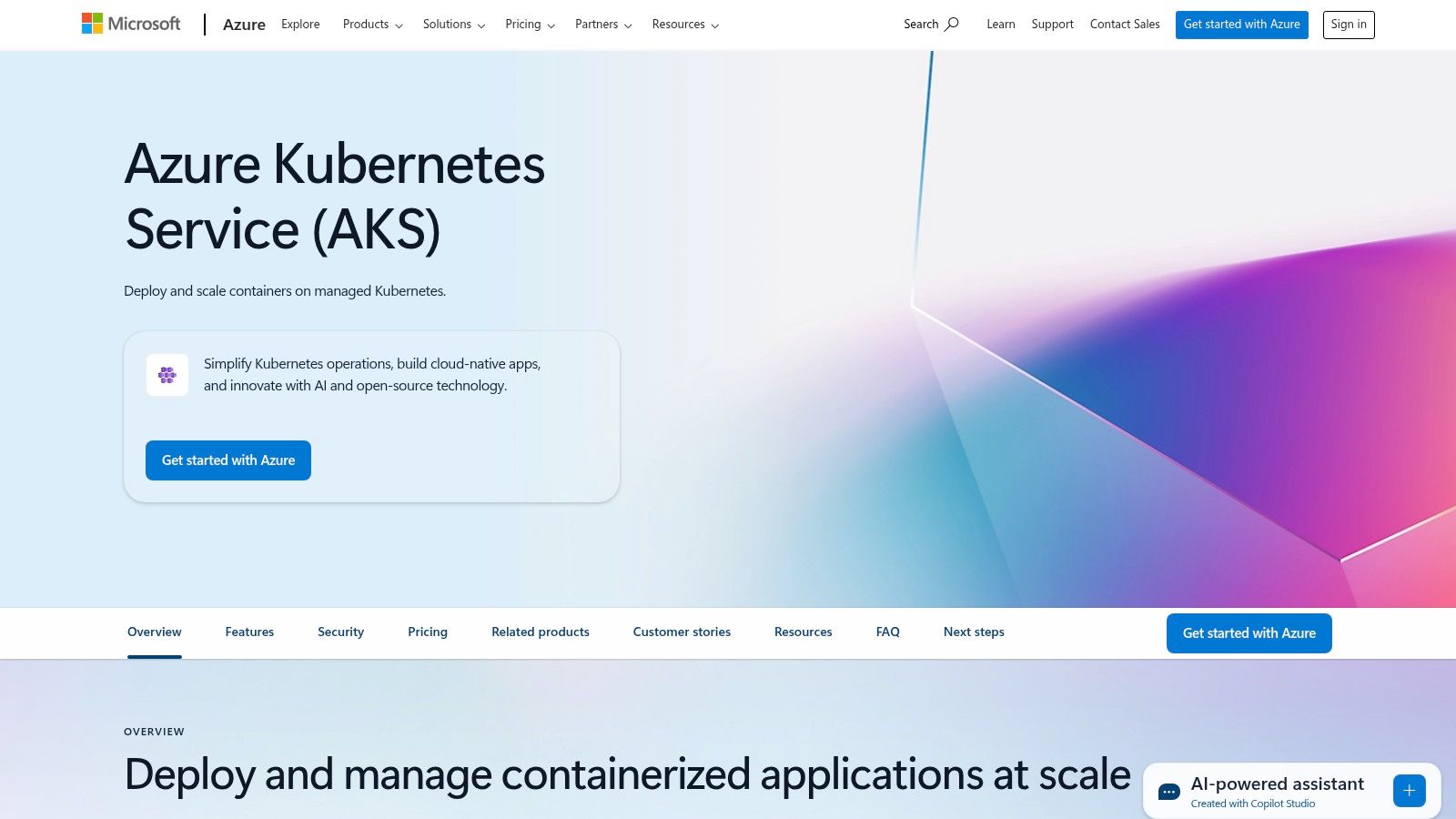
This tight integration with the broader Azure platform is its core strength. It enables seamless connections to other Azure services like Azure Monitor, Azure Policy, and Azure Logic Apps, creating a cohesive and powerful cloud-native development experience. The service also uniquely supports both Linux and Windows Server containers within the same cluster, making it a versatile choice for a wide range of application portfolios.
Core Features & Use Cases
AKS is ideal for enterprises that have standardised on Azure as their primary cloud provider. A common use case involves migrating existing .NET applications to a modern, container-based architecture, leveraging AKS’s native support for Windows containers. It also excels in building scalable microservices, where developers can utilise Azure Functions and other serverless components alongside their AKS-hosted services for event-driven processing. For machine learning workloads, AKS provides GPU-enabled nodes, making it a robust platform for training and deploying AI models at scale.
- Azure Active Directory Integration: Secure clusters with enterprise-grade identity and access management.
- Integrated Developer Tools: Offers extensions for Visual Studio Code and Visual Studio for a streamlined inner-loop development workflow.
- Automated Management: Handles health monitoring, patching, and automated upgrades for the Kubernetes control plane.
Implementation & Considerations
Getting started with AKS is straightforward through the Azure portal, CLI, or infrastructure-as-code tools like Terraform. While Microsoft manages the control plane for free, users pay only for the virtual machines (nodes), storage, and networking resources consumed by their clusters. This pricing model makes it accessible for various scales of deployment. The primary consideration is vendor lock-in; since AKS is deeply tied to Azure’s infrastructure and services, migrating away from it can be a complex and costly endeavour. Therefore, it is best suited for organisations committed to the Azure ecosystem for the long term.
11. IBM Cloud Kubernetes Service (IKS)
Targeting enterprises with stringent security and compliance needs, IBM Cloud Kubernetes Service (IKS) is a managed offering that simplifies the deployment of containerised applications. It stands out by integrating robust security features directly into the Kubernetes platform, providing a secure, certified environment out of the box. IKS is designed to abstract away the operational complexities of managing Kubernetes, allowing DevOps teams to focus on application development and deployment within the IBM Cloud ecosystem.
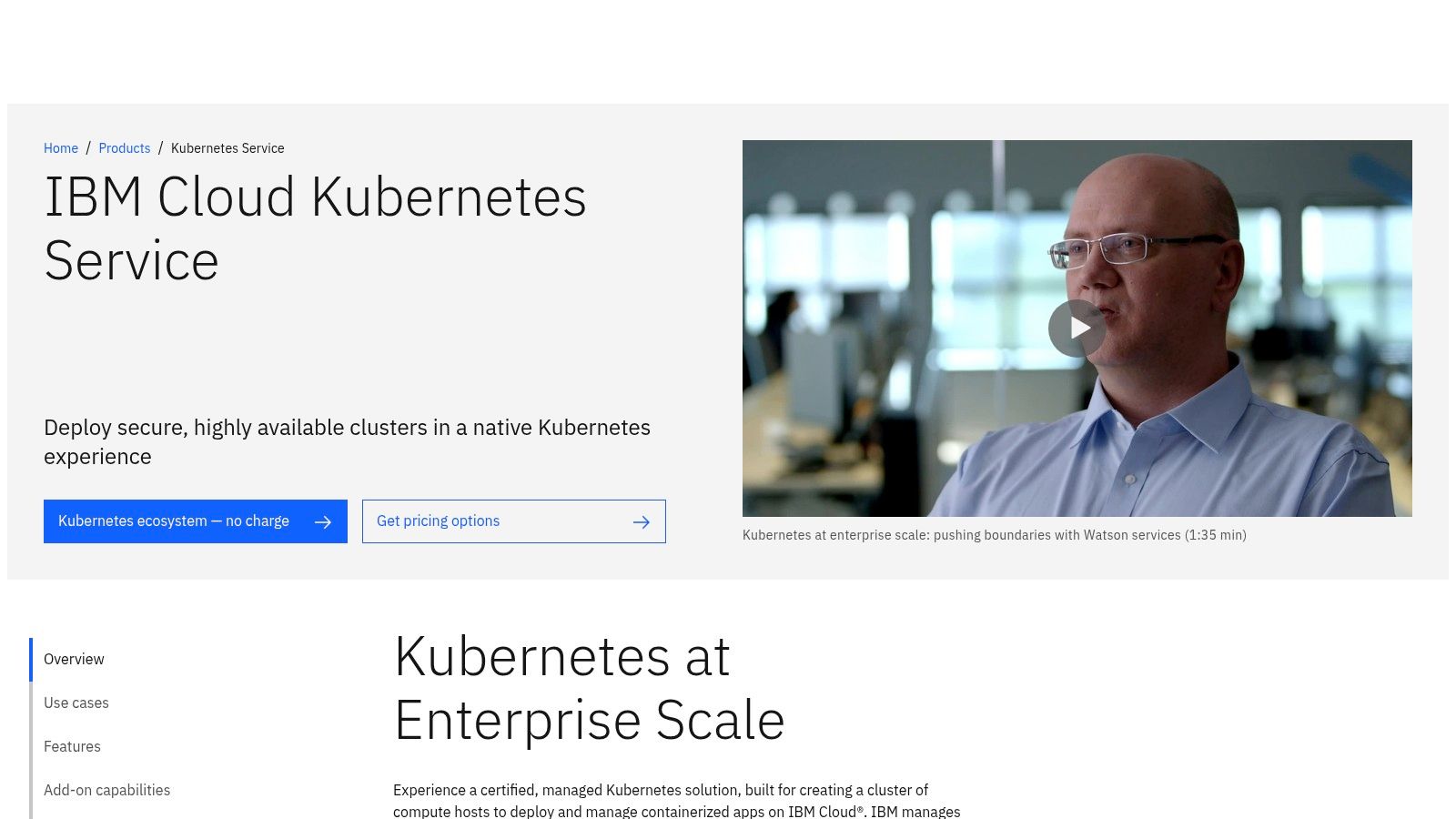
The service automates master node management, including updates and security patching, while offering high availability through multi-zone cluster deployments. This focus on security, isolation, and simplified management makes it a strong contender among container orchestration tools for businesses already invested in or considering IBM’s cloud platform.
Core Features & Use Cases
IKS is particularly well-suited for regulated industries like finance, healthcare, and government, where built-in security and compliance capabilities are paramount. A common use case is deploying sensitive applications that process personal or financial data, leveraging IBM’s isolation options and vulnerability scanning. It also excels at running AI and machine learning workloads, integrating seamlessly with services like Watson AI. For organisations pursuing a hybrid cloud strategy, IKS can be combined with IBM Cloud Satellite to manage on-premises Kubernetes clusters from a single control plane.
- Managed Control Plane: IBM handles the provisioning, operation, and maintenance of the Kubernetes master.
- Integrated Security: Features include image vulnerability scanning, network policy enforcement, and options for isolated compute nodes.
- Multi-Zone Availability: Easily create clusters that span multiple availability zones to ensure high resilience and uptime.
Implementation & Considerations
Getting started with IKS is straightforward, with cluster creation manageable via the UI, CLI, or API. However, its primary limitation is that it operates exclusively within the IBM Cloud, leading to potential vendor lock-in. While this tight integration simplifies access to other IBM services like Db2 and Watson, it restricts portability compared to more platform-agnostic solutions. The pricing model includes a free cluster tier for experimentation, with paid plans based on worker node resources. For successful implementation, teams should leverage IBM’s extensive documentation and tutorials, paying close attention to network configuration and security group settings.
12. DigitalOcean Kubernetes (DOKS)
Positioned as a developer-friendly entry point into the world of managed Kubernetes, DigitalOcean Kubernetes (DOKS) simplifies the deployment and management of containerised applications. As one of the more accessible container orchestration tools, DOKS abstracts away much of the underlying complexity associated with setting up a K8s cluster. It is designed for startups, small businesses, and individual developers who need the power of Kubernetes without the steep learning curve and operational overhead often associated with larger, more feature-heavy platforms.
The service provides a streamlined user interface and API, allowing for the rapid provisioning of fully functional Kubernetes clusters. This focus on simplicity and cost-effectiveness makes it an attractive alternative for projects that do not require the extensive, enterprise-grade feature set of providers like AWS or Google Cloud, but still demand a robust and scalable environment for their applications.
Core Features & Use Cases
DOKS is ideal for straightforward use cases such as hosting web applications, APIs, and microservices where rapid development and deployment are key priorities. It excels in environments where developer productivity is paramount, enabling teams to launch a production-ready cluster in minutes. A primary use case is for companies already leveraging other DigitalOcean services, as it integrates seamlessly with products like Droplets, Volumes Block Storage, and Load Balancers for a cohesive infrastructure experience. It is also a popular choice for staging and testing environments due to its predictable and affordable pricing.
- Managed Control Plane: DigitalOcean handles the complexity of managing, scaling, and maintaining the Kubernetes control plane for free.
- Auto-Scaling: Automatically adjusts the number of nodes in a cluster based on workload demands to optimise performance and cost.
- Simple Integration: Natively integrates with the DigitalOcean ecosystem, including Load Balancers and block storage.
Implementation & Considerations
The primary advantage of DOKS is its straightforward setup and management. However, its greatest strength is also its main limitation; it is tied exclusively to the DigitalOcean infrastructure. This can be a drawback for organisations pursuing a multi-cloud or hybrid strategy. While DOKS supports core Kubernetes functionalities, it lacks some of the advanced networking, security, and compliance features found in larger competitors like EKS or GKE. The cost of ownership is highly transparent, based on the price of the underlying Droplets (worker nodes) and other resources like storage, with the control plane offered at no extra cost. This makes it an excellent, low-risk platform for teams to start their Kubernetes journey.
Container Orchestration Tools Comparison
| Solution | Core Features & Capabilities | User Experience & Quality | Value Proposition | Target Audience | Unique Selling Points | Price Points |
|---|---|---|---|---|---|---|
| Kubernetes | Auto scaling, self-healing, load balancing | Highly flexible, strong community | Open-source, extensible | DevOps, enterprises | Extensive docs, multi-runtime support | Free (open-source) |
| Docker Swarm | Native Docker clustering, rolling updates | Simple setup, lightweight | Seamless Docker integration | Small teams, Docker users | Ease of use, low resource demands | Free (open-source) |
| Red Hat OpenShift | Automated upgrades, CI/CD, multi-cloud support | Enterprise security, strong tools | Enterprise-ready, enhanced security | Large enterprises, hybrid clouds | Integrated pipelines, compliance features | Paid (enterprise pricing) |
| HashiCorp Nomad | Supports containers & traditional workloads, multi-dc | Lightweight, easy setup | Versatile orchestration | Mixed workload teams | HashiCorp tool integration (Vault, Consul) | Free/Open-source + enterprise |
| Apache Mesos | Resource sharing, scalable, fault-tolerant | Highly scalable, complex | Efficient big data & container support | Large-scale clusters, data teams | Framework agnostic, fault tolerance | Free (open-source) |
| Rancher | Multi-cluster mgmt, monitoring, security | User-friendly UI | Simplifies Kubernetes management | Kubernetes admins, SMEs | Centralized multi-K8s support | Free (open-source) |
| Portainer | Multi-cluster, RBAC, templates | Intuitive UI | Easy container mgmt across envs | Developers, small teams | Cross-platform container mgmt | Free + paid tiers |
| Amazon EKS | Managed K8s, AWS integration, automated upgrades | Reliable, seamless AWS integration | Simplifies Kubernetes on AWS | AWS users, enterprises | Deep AWS service integration | Pay-as-you-go via AWS |
| Google Kubernetes Engine (GKE) | Auto-scaling, logging, multi-cloud support | Easy setup, strong GCP integration | Managed, scalable K8s on Google Cloud | GCP customers, cloud-native apps | Google production expertise | Pay-as-you-go via GCP |
| Azure Kubernetes Service (AKS) | Fully managed, AAD integration, auto upgrades | Easy to use, integrates with Azure | Managed K8s with Microsoft tools | Azure users, enterprises | VS Code & Windows container support | Pay-as-you-go via Azure |
| IBM Cloud Kubernetes Service (IKS) | Managed clusters, compliance, multi-zone availability | Secure, enterprise ready | Enterprise security and compliance | IBM Cloud users, regulated sectors | Built-in compliance, IBM services | Pay-as-you-go via IBM Cloud |
| DigitalOcean Kubernetes (DOKS) | Managed K8s, load balancers, monitoring | Simple, cost-effective | Affordable K8s for developers | Startups, small teams | Easy onboarding, competitive pricing | Affordable plans |
Orchestrating Your Future: Making the Final Call
Navigating the complex landscape of container orchestration tools can feel like conducting a symphony with an unfamiliar score. We have explored the titans of the industry like Kubernetes, the accessible simplicity of Docker Swarm, and the specialised power of platforms such as Red Hat OpenShift and HashiCorp Nomad. We’ve also delved into the managed Kubernetes offerings from major cloud providers like AWS, Google Cloud, and Azure, which promise to abstract away the operational overhead. The central takeaway is clear: there is no single “best” tool, only the one that best aligns with your organisation’s unique technical requirements, team expertise, and business objectives.
The decision-making process is not merely a feature-for-feature comparison. It is a strategic choice that will profoundly impact your development workflows, infrastructure costs, and ability to scale. Your selection hinges on answering a few critical questions about your operational reality. What is the current skill level of your DevOps team? How much control over the underlying infrastructure do you truly need? Is vendor lock-in a significant concern for your long-term strategy? The answers will guide you toward the right solution.
Key Factors to Guide Your Decision
Choosing from the extensive list of container orchestration tools requires a deliberate and structured approach. Before you commit, weigh these pivotal factors:
- Complexity vs. Control: Kubernetes and its powerful distributions like OpenShift offer unparalleled control and a vibrant ecosystem. However, this power comes with a steep learning curve and significant operational responsibility. Tools like Docker Swarm or HashiCorp Nomad priorities simplicity and ease of use, making them ideal for smaller teams or less complex workloads where a faster time-to-market is crucial.
- Ecosystem and Community Support: The de facto dominance of Kubernetes means it has the largest community, the most extensive documentation, and the widest array of third-party integrations. This is a massive advantage when troubleshooting issues or looking for pre-built solutions. While other tools have dedicated communities, they may not offer the same breadth of resources.
- Managed vs. Self-Hosted: Managed services like Amazon EKS, Google GKE, and Azure AKS are game-changers. They handle the difficult parts of running a control plane, such as patching, scaling, and ensuring high availability. This frees up your team to focus on applications, not infrastructure. The trade-off is often reduced flexibility and potential cloud provider lock-in. A self-hosted solution offers ultimate customisation but demands deep expertise and a dedicated team for maintenance.
- Workload Specificity: Consider the nature of your applications. Are you running a mix of containerised and non-containerised workloads? HashiCorp Nomad excels in this hybrid environment. Are you deeply embedded in a specific enterprise ecosystem? Red Hat OpenShift might be the most integrated and secure choice. For straightforward container management, a lightweight tool like Portainer on top of Docker Swarm could be perfectly sufficient.
Your Actionable Next Steps
Making the final call is an iterative process, not a one-time event. To move forward with confidence, we recommend the following steps:
- Define Your Core Requirements: Document your non-negotiable needs. List your top priorities, whether they are ease of use, raw performance, security compliance, or multi-cloud portability.
- Conduct a Proof of Concept (PoC): Shortlist two or three promising candidates and run a PoC. Deploy a representative application on each platform to gain real-world experience with its deployment process, monitoring capabilities, and day-to-day operational feel. This is the most effective way to validate your assumptions.
- Calculate the Total Cost of Ownership (TCO): Look beyond the sticker price. Factor in the cost of engineering time for setup and maintenance, training for your team, and any necessary commercial licences or support contracts. A “free” open-source tool can quickly become expensive without the right in-house expertise.
Ultimately, the goal of adopting any of these container orchestration tools is to empower your teams, accelerate innovation, and build resilient, scalable applications. The right platform will feel less like a complex burden and more like a strategic enabler for your business.
Making this critical infrastructure decision can be daunting, especially when your team is focused on product development. If you need expert guidance to navigate this landscape, assess your specific needs, and implement the right orchestration strategy, the specialists at Signiance Technologies can help. We provide end-to-end DevOps consulting to ensure your infrastructure is a powerful asset, not a bottleneck. Contact Signiance Technologies to start your journey toward seamless orchestration today.
